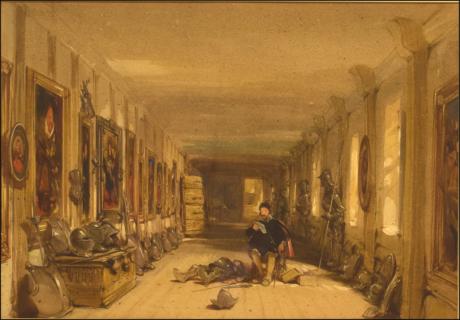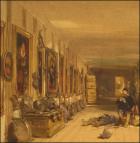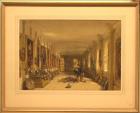Cattermole, George (1800–1868), watercolour painter and illustrator, was born on 10 August 1800 in the village of Dickleburgh, near Diss, Norfolk, the youngest of seven children, six sons and a daughter, of parents whose names are not known.
Cattermole's mother died when he was very young and he was raised and taught by his father, a man of independent means. He was a great reader, familiar with Shakespeare and Scott from an early age. Cattermole knew history well, especially English history, was a good Latin scholar, and wrote in a correct and classic style. He may have served as an assistant at his father's school in Norfolk before his departure for London, where he arrived by 1819.
Soon thereafter, Cattermole began work as an architectural draughtsman for the antiquary John Britton and developed his skills of observation and accuracy, training congenial with his antiquarian and artistic interests.
With one of his brothers, the Revd Richard Cattermole (1795?–1858), Cattermole contributed to two of Britton's most important series of publications: Cathedral Antiquities of England (14 vols., 1814–35) and The Architectural Antiquities of Great Britain (1807–26). Of the former Cattermole contributed to four volumes and Richard to three. Some of the most elaborate engraved drawings appear above the name of George Cattermole: nineteen in the volume on Canterbury and seven in that for Oxford, both published in 1821, twelve for Wells in 1824, and one drawing for Peterborough in 1828. Eighteen engravings after Cattermole's drawings appear in the fifth volume (1826) of Architectural Antiquities.
Cattermole illustrated numerous books. Evenings at Haddon Hall (1832), edited by the baroness de Calabrella, contained twenty-four fancy subjects, which were ‘supposed to be in a portfolio, turned over by a birthday party, confined to the house at Haddon by the snow’ (Roget, 2.73). In the 1830s Cattermole travelled to Scotland to sketch localities mentioned in the Waverley novels by Walter Scott. Five drawings illustrating scenes from four of Scott's novels were exhibited between 1836 and 1850 at the Old Watercolour Society. Certain of Cattermole's drawings were engraved for illustrations to later editions of the Waverley novels. Twenty-one engravings after drawings by Cattermole were published in Heath's Pictorial Annual for 1835: Scott and Scotland by Leitch Ritchie. In his art Cattermole gave visual expression to Scott's evocation of a bygone age in Scotland. He also illustrated volumes 1 (1841) and 2 (1844) of Richard Cattermole's The Great Civil War of Charles I and the Parliament, with a total of twenty-eight engravings after his picturesque and vigorous sketches.
Cattermole enjoyed riding as a young man, and was an excellent carriage driver. His natural vivacity and good fellowship caused him to be a general favourite. He was a good conversationalist in both French and Spanish, and a man of literary tastes, who preferred intellectual associates of the more brilliant kind. An intimate of Count d'Orsay and Lady Blessington at Gore House, he was part of their circle of fashionable people from the worlds of art and literature in London. He was a member of the Garrick Club, and in 1838 was elected to the Athenaeum. In the late 1830s he moved into a suite of private chambers in The Albany, formerly occupied first by Lord Byron (of whom he made a posthumous drawing now in a private collection, after the portrait by Richard Westall, 1813) and later by Edward Bulwer-Lytton. Cattermole included among his close friends Robert Browning, Bulwer-Lytton, Charles Dickens, Benjamin Disraeli, Douglas Jerrold, Sir Edwin Landseer, Thomas Macaulay, Daniel Maclise, William Macready, Clarkson Stanfield, and William Makepeace Thackeray. In July 1839, as a result mainly of the positive reception to his drawing Luther and his Adherents at the Diet of Spires (1839; V&A), Cattermole was offered a knighthood, which he modestly declined. This was one of several incidents in which ‘he thought fit to decline proposals the acceptance whereof might have been of advantage to him in the world’ (Roget, 2.64).
Just before the publication of his first illustrations, Cattermole began to exhibit his architectural drawings. Two of Peterborough Cathedral appeared at the Royal Academy in 1819 and 1822, and a drawing of Wells Cathedral was shown at the Society of Painters in Water Colours in 1821. Altogether he exhibited 105 works between the years 1819 and 1850: six drawings at the Royal Academy between 1819 and 1827, two works at the British Institution in 1827, and, most importantly, from 1822 to 1850, ninety-seven drawings at the Society of Painters in Water Colours, which established his fame. He was elected an associate on 6 April 1822 and, having allowed his associateship to lapse, again on 9 February 1829, before becoming a full member on 10 June 1833. Cattermole became the foremost British historical painter in watercolours, influenced by the examples of two fellow countrymen in the same medium: the intimate historical subjects of Richard Parkes Bonington and the bold and loose handling of colour by David Cox.
Among the principal works Cattermole exhibited at the Old Watercolour Society were: Sir Walter Raleigh Witnessing the Execution of the Earl of Essex in the Tower (1839), The Contest for the Bridge (1844; V&A), and Benvenuto Cellini Defending the Castle of St. Angelo (1845). Although The Diet of Spires proved to be a great popular triumph in 1839, Cattermole considered it one of his least successful works, calling it laboured, because he was obliged to follow portraits and other authorities, when he abhorred copying from any sort of model.
In his earlier drawings Cattermole's practice had been to use transparent watercolours. However, in his more mature work he used body colour lavishly, painting with a loaded brush on thick absorbent paper, of a low tone and warm tint, prepared especially for him by Messrs Winsor and Newton and known by his name. Cattermole opposed the heavy gold ‘exhibition’ frames then in use by galleries, considering that his delicately coloured drawings were seen to better advantage surrounded by a white matt.
Cattermole's last large-scale exhibited work was The Unwelcomed Return (1846), deemed ‘a work of such power as not to be equalled in its kind by the utmost effort of any living artist’ (‘Society of Painters’, 1846, 190–91). An exhibition review of 1847 opened with a comment about the lack of paintings from certain members: ‘others, to whom all lovers of Art have been accustomed to look with interest, are absent. Mr. Cattermole contributes nothing … there are blanks in the Exhibition which will not be readily filled up’ (‘Society of Painters’, 1847, 201). Cox, a fellow member of the Old Watercolour Society, stated in a letter: ‘The great man, Cattermole, has behaved rather shabby; he has not sent one drawing’ (Solly, 148). Additionally, Cattermole enjoyed the society of Royal Academicians more than that of his fellow members of the Old Watercolour Society. From 1845 to 1850 he showed only small drawings, and he showed nothing at all in 1851. An announcement at the end of the exhibition catalogue drew attention to his serious illness. By 29 December 1851 Cattermole was so severely ill that relatives and friends were summoned to his bedside. In June 1852 he retired from the Old Watercolour Society, in part to become a painter in oils, but also because he appeared to be unsuited to the rigours of the exhibition schedule.
In 1838 Cattermole met Clarissa Hester, the daughter of James Elderton, a deputy remembrancer of the court of the exchequer and a distant maternal relation of Dickens; they were married on 20 August 1839 at St Marylebone, Middlesex. They lived in the rural suburb of Clapham Rise until 1863, and there brought up nine children, four sons and five daughters. They were a close family who lived on terms of great mutual affection.
Travelling from Charing Cross Station by omnibus to Clapham, Cattermole closely observed the driver, to whom he gave the sobriquet Sloppy. He imitated his Cockney accent, speaking ‘in the gruff, hoarse accents of what seemed to be the remains of a deep bass voice wrapped up in wet straw’ (Forster, 2.393), and related nonsense about the eccentricities of Sloppy's imaginary friend Jack. These stories encapsulated the driver's hard experiences before he became a convert to temperance and delighted both William Powell Frith and Dickens, who recorded some of them in dialect and incorporated them into his later novels. Cattermole had a keen sense of humour, was almost prudish in regard for the conventionalities of life, and was a tory in his politics. His speech was precise and measured and he had a horror of vulgarity. Few artists dressed as well as he. Cattermole was a member of the Portwiners and the Shakespeare Society, for whom he gave frequent dinner parties; these were served by white-gloved servants in their spacious dining-room, fitted with Byron's carved furniture from his Albany chambers and hung with wallpaper decorated with gold bars, designed by Cattermole himself (Cohen, 131). Those were ‘red-letter days when Dickens, Thackeray, Landseer, et al. gathered at the Cattermole residence in Clapham Rise, on which occasions they retired to brew punch in the studio filled with picturesque armour, tapestry, carved furniture’ (Kitton, 135).
John Forster describes Dickens's opinion of Cattermole, as one of his companions at Twickenham in the late 1830s:
another painter-friend was George Cattermole, who had then enough and to spare of fun as well as fancy to supply ordinary artists and humourists by the dozen, and wanted only a little more ballast and steadiness to possess all that could give attraction to good-fellowship. (Forster, 1.104–5)
Dickens commissioned Cattermole as an illustrator for his fourth and fifth novels, The Old Curiosity Shop (1840–41) and Barnaby Rudge (1841). Both were first published in weekly part sets in Master Humphrey's Clock, illustrated with woodcuts dropped into the text. Dickens offered Cattermole sentimental, heartfelt, and picturesque subjects, especially those involving his heroine little Nell in The Old Curiosity Shop. Shortly after Cattermole completed these Dickens commissioned a pair of watercolours: Little Nell's Home (Dickens House Museum, London) and its companion Little Nell's Grave (V&A), both of which were in Dickens's possession until his death.
In 1845 Dickens asked Cattermole to play Downright in a production by his amateur theatrical company of Ben Jonson's comedy Every Man in his Humour. Cattermole turned Dickens down for the initial performance, but he did act with the company for two additional presentations, in the character of Well-Bred.
Cattermole's oil painting was not successful. Although accustomed to the copious use of body colour, his hand felt weighted by the task of dragging the more viscid medium of oil. He soon longed for the freer play he enjoyed when working in watercolour and returned to that medium, working at the easel with intense and unremitting devotion from early dawn until past midnight. Few of these late watercolours were seen or exhibited, and they seem to have gone from his studio directly into the hands of collectors.
Yet Cattermole's greatest successes in public exhibition outside London followed his resignation from the Old Watercolour Society. The eleven works he exhibited at the Universal Exhibition in Paris in 1855 created a sensation, and he was awarded a medal of honour. He was appointed a member of the Academie voor Beelende Kunsten, Amsterdam, on 13 February 1856 and invited to join the Belgian Society of Watercolour Painters. He exhibited thirty-one works in the Manchester Art Treasures exhibition in 1857 and thirteen works at the International Exhibition of 1862 in London.
Increasingly frail and reclusive, Cattermole was concerned for the future of his family. In the summer of 1856 Dickens wrote of the ‘unhappy Cattermoles’ living in a seaside villa let by his landlord, who complained that the Cattermoles never paid their bills. In London the family moved from Clapham Rise to Clapham Common in the early 1860s, for reasons of economy. The unexpected deaths of two of their children were a huge shock to Cattermole and his wife. Their youngest daughter died from gastric fever in 1862, and in September 1863 their eldest son, Ernest George, an officer in the Bengal army, died. These losses, aggravated by financial anxieties and worsened by his self-imposed seclusion, caused Cattermole to retire completely from society and he fell into a severe depression. He died at his home, 4 Cedars Road, Clapham Common, on 24 July 1868, leaving a widow, three sons, and four daughters. He was buried at Norwood cemetery near his first mentor, John Britton.
Cattermole was remembered as ‘the most affectionate of husbands and fathers’ (Taylor, 93). Several efforts were made to provide for the bereaved Cattermole family: Dickens started a private appeal, whose funds were turned over to Mrs Cattermole in mid-April 1869. A petition to the Royal Academy failed. At the request of Cattermole's old friend Disraeli, Queen Victoria placed Mrs Cattermole on the civil list for a pension of £100 per year. An auction of Cattermole's paintings, drawings, and books was held at Christies on 9 March 1869. Following his death ten works by Cattermole were shown at the Royal Jubilee Exhibition at Manchester in 1887. In April of the same year the Royal Society of Painters in Water Colours assembled forty drawings for a solo exhibition. In March 1889 Messrs J. and W. Vokins showed 117 of his works.
There are numerous drawings by Cattermole in public collections, as well as signed autograph letters, sketches, and notebooks. The Victoria and Albert Museum, in the Ellison gift and the Ashbee, Dixon, Forster, Harrod, and Townshend bequests, holds the principal collection of his work.
His most fertile period was between 1833 and 1850. At the Paris Exhibition of 1855 he received one of the five first-class gold medals awarded to British painters. He also enjoyed professional honors in Amsterdam and in Belgium. Among his leading works are The Murder of the Bishop of Liege, The Armourer relating the Story of the Sword, The Assassination of the Regent Murray by Hamilton of Bothwellhaugh, and (in oil) A Terrible Secret.
He was largely employed by publishers, illustrating the Cathedral Antiquities of England produced by John Britton, the Waverley Novels, and the Historical Annual of his brother Richard Cattermole (his scenes from the wars of Cavaliers and Roundheads in this series are among his best engraved works), and many other volumes besides. He collaborated on illustrations for Dickens's The Old Curiosity Shop and Barnaby Rudge. Cattermole specialized in rendering scenes of chivalry, of medievalism, and generally of the romantic aspects of the past.
Della Clason Sperling DNB



